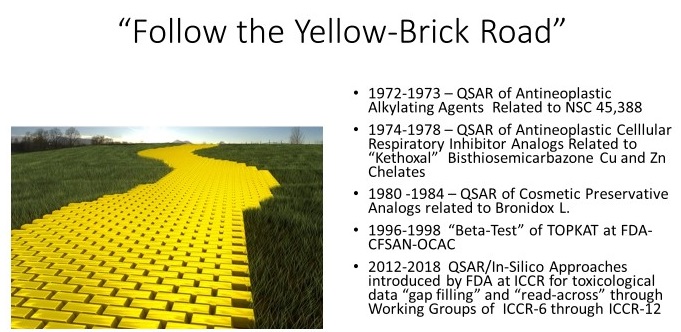PART TWO
FOLLOW THE YELLOW BRICK ROAD: MY FIRST STEPS (ACADEMIA)
I first discovered the QSAR Paradigm in the late 1960s while still a graduate student studying “medicinal chemistry”, having already been introduced during classes in “physical-organic chemistry” to the concepts of “substituent effects” (electronic, steric) and “linear free energy relationships (LFER)” correlating chemical reactivity and substituent constant effects (i.e., Hammett, Taft). The logic of extending such approaches to rational mechanism-based correlations involving biochemical and toxicological reactivity at the cellular, subcellular, and molecular levels by including considerations of “hydrophobicity”, then only recently having been introduced by Dr. Corwin H. Hansch (Pomona College) and modeled by a new “octanol-water partition coefficient (Log P) and functional group moiety substituent constant (pi)”, was an intriguing “siren song” to me, an area of research to which I simply must be a contributor.
.jpg?ver=iSTmArwnv1I09xU1c_Tmbg%3d%3d) In 1971, I took a chance in writing to Dr. Hansch, humbly seeking a postdoctoral fellowship in his laboratory (Pomona College, Seaver Science Center, Claremont, CA), and, backed by a fine letter of recommendation from my professor of medicinal chemistry (Dr. Irwin J. Pachter, then-Director of Medicinal Chemistry Research, Endo Laboratories), surprisingly, my application was rewarded by an offer of a 1-yr. postdoctoral position; shortly thereafter, “Westward-ho” I went, “following the yellow brick road” to begin my exploration of the QSAR Paradigm in Claremont, California.
In 1971, I took a chance in writing to Dr. Hansch, humbly seeking a postdoctoral fellowship in his laboratory (Pomona College, Seaver Science Center, Claremont, CA), and, backed by a fine letter of recommendation from my professor of medicinal chemistry (Dr. Irwin J. Pachter, then-Director of Medicinal Chemistry Research, Endo Laboratories), surprisingly, my application was rewarded by an offer of a 1-yr. postdoctoral position; shortly thereafter, “Westward-ho” I went, “following the yellow brick road” to begin my exploration of the QSAR Paradigm in Claremont, California.
During my tenure at Pomona College, we developed QSAR relationships involving anti-tumor activity in several series of Dacarbazine Dome® analogs (DTIC, NSC 45,388), then used to treat malignant melanoma. Our “latent” alkylating agent analogs were linear 1-X-aryl-3,3-dialkyl triazenes, which were subsequently tested at the National Cancer Institute (NIH/NCI) versus L-1210 Leukemia in mice (see, J. Med Chem., 21, 563 (1978)).
I continued to “follow the yellow brick road” in a “trek” back to the Midwest, this time not to “the Emerald City of Oz” but to the Queen City of Cincinnati, OH ("Gateway to the South”), and a 4-yr. postdoctoral appointment in QSAR (computer-assisted drug design (CADD)) research in the laboratory of Dr. Eugene A. Coats (University of Cincinnati College of Pharmacy, Dept. of Medicinal Chemistry), one of Dr. Hansch’s earlier postdocs, into so-called “cellular respiratory inhibitors” to optimize “selective toxicity” and antineoplastic activity of congeners of arylglyoxal bisthiosemicarbazone copper and zinc chelates in the Swiss White Mouse Ehrlich Ascites Carcinoma Model (vs. normal rat liver) (see, J. Med. Chem., 19 (No. 1), 131 (1976); J. Med. Chem., 21, 804 (1978); Il Farmaco, 38 (no. 3), 143 (1983)).
FOLLOW THE YELLOW BRICK ROAD: NEXT STEPS (COSMETIC INDUSTRY)
Employers and peers in the cosmetic industry and, later, in government, did not always fully appreciate the full potential of the QSAR Paradigm and were often loath (or funds were not available) to partially or fully fund my investigations. My path forward in introducing the QSAR Paradigm to the cosmetic industry was thus by no means linear and, indeed, seemed at times more like “Brownian Motion”. Nor should it be assumed that I was always able to stay focused and single-purposed over the next 2 decades in pursuing applications of the QSAR Paradigm. After all, my initial employer in the early 1980s, the Andrew Jergens Co, (Cincinnati, OH), was a cosmetic and soap manufacturer and marketer, not really interested in the development of new optimized cosmetic raw materials, and my primary job was bar soap formulation initially and, then, finished product safety and claims substantiation, rather than raw material design and synthesis!
However, following the “80-20 rule”, I was able to spend one day each week in research activities, which resulted in a poster presented at the 1980 SCC Annual Scientific Meeting, followed by publication in the Journal of the Society of Cosmetic Chemists (now the Journal of Cosmetic Science) of a single QSAR study on the optimization of antimicrobial cosmetic preservative congeners related to the commercially marketed cosmetic preservative, Bronidox L®, funded by a small SCC Graduate Student Fellowship and supported by Dr. J. Leon Lichtin at the UC College of Pharmacy; this work used as a measure of “relative biological activity (RBR)” the microbial kinetic kill rate parameter, “decimal reduction time (D-Value)”, a concept from the annals of food microbiology then newly introduced by Dr. Donald S. Orth. (see, S.R. Milstein, D.S. Orth, and J. L. Lichtin, JSCC, 35 (2), 73-93 (1984)).
Otherwise, stay tuned for the conclusion – Follow the Yellow Brick Road: Final Steps (FDA and ICCR)
